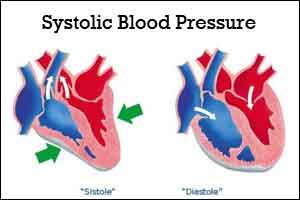- Home
- Editorial
- News
- Practice Guidelines
- Anesthesiology Guidelines
- Cancer Guidelines
- Cardiac Sciences Guidelines
- Critical Care Guidelines
- Dentistry Guidelines
- Dermatology Guidelines
- Diabetes and Endo Guidelines
- Diagnostics Guidelines
- ENT Guidelines
- Featured Practice Guidelines
- Gastroenterology Guidelines
- Geriatrics Guidelines
- Medicine Guidelines
- Nephrology Guidelines
- Neurosciences Guidelines
- Obs and Gynae Guidelines
- Ophthalmology Guidelines
- Orthopaedics Guidelines
- Paediatrics Guidelines
- Psychiatry Guidelines
- Pulmonology Guidelines
- Radiology Guidelines
- Surgery Guidelines
- Urology Guidelines
Intensive blood pressure lowering treatment doesn't reduce death or CVD : JAMA

Blood pressure lowering treatment does not reduce death or cardiovascular disease in healthy individuals with a systolic blood pressure below 140. This is shown in a systematic review and meta-analysis from Umeå University. The results, published in JAMA Internal Medicine, support current guidelines and contradict the findings from the Systolic Blood Pressure Intervention Trial (SPRINT).
Blood pressure treatment goals have been intensively debated since the publication of the SPRINT study in 2015. While current guidelines recommend a systolic blood pressure goal < 140 mm Hg, SPRINT found additional mortality and cardiovascular disease reduction with a goal < 120 mm Hg.
A systematic review and meta-analysis from Umeå University, published in JAMA Internal Medicine, contradicts these findings. The Umeå study shows that treatment does not affect mortality or cardiovascular events if systolic blood pressure is < 140 mm Hg. The beneficial effect of treatment at low blood pressure levels is limited to trials in people with coronary heart disease.
"Our findings are of great importance to the debate concerning blood pressure treatment goals," says Dr Mattias Brunström, the researcher at the Department of Public Health and Clinical Medicine, Umeå University, and lead author.
The study is a meta-analysis, combining data from 74 randomized clinical trials, including more than 300 000 patients. The researchers separated primary preventive studies from studies in people with coronary heart disease or previous stroke. The analysis found that the treatment effect was dependent on how high blood pressure was in previously healthy individuals. If systolic blood pressure was above 140 mm Hg, treatment reduced the risk of death and cardiovascular disease. Below 140 mm Hg, treatment did not affect mortality or the risk of first-ever cardiovascular events.
"Several previous meta-analyses have found that blood pressure lowering treatment is beneficial down to levels below 130 mm Hg. We show that the beneficial effect of treatment at low blood pressure levels is limited to trials in people with coronary heart disease. In primary preventive trials, the treatment effect was neutral," says Mattias Brunström.
For more details click on the link: http://dx.doi.org/10.1001/jamainternmed.2017.6015

Disclaimer: This site is primarily intended for healthcare professionals. Any content/information on this website does not replace the advice of medical and/or health professionals and should not be construed as medical/diagnostic advice/endorsement or prescription. Use of this site is subject to our terms of use, privacy policy, advertisement policy. © 2020 Minerva Medical Treatment Pvt Ltd